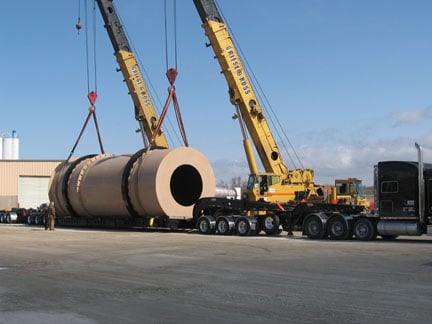While the heap leaching process has proven to be efficient and cost-effective, efficiency and ore recovery can be further improved through the addition of an agglomeration drum.
The following covers an introduction to heap leaching, and how agglomeration greatly improves this essential beneficiation process.
A Look at the Heap Leaching Process
Heap leaching is a hydrometallurgical approach to ore beneficiation. Upon removal from the ground, mined ore is sent through a crusher to break the ore down into fines. The ore fines are then “heaped,” into a large pile. This mound is then irrigated with a special solution (referred to as the leachate) that is dependent upon the type of ore being extracted. In the case of copper, for example, sulfuric acid is used, because it reacts with the copper to create Copper Sulfate, a by-product that has many potential reuse applications.
The irrigated ore pile is allowed to sit for a specified length of time, allowing the leachate to percolate through the ore and drain to the bottom of the heap. Once the impregnated solution is collected at the bottom of the heap, it can be purified to extract the valuable target material.
While this process is efficient on its own, efficiency is greatly improved through the addition of an agglomeration drum.
What is an Agglomeration Drum?
Agglomeration drums, also called ore drums, agglomerators, and heap leaching drums, are based on a rotary drum design: a large, rotating drum tumbles material through its interior to accomplish the process goal.
In the case of the heap leaching process, ore fines are tumbled through the drum prior to heaping on the leach pad. Leachate is added into the drum as well, promoting the mixture of fines and leachate, while also agglomerating fines into a more uniform particle size distribution.
Benefits of Incorporating an Agglomeration Drum into the Heap Leaching Process
There are two main benefits to including an agglomeration drum in the heap leaching process:
Uniformity of Ore Fines
Heap leaching relies on the ability of the leaching solution to penetrate through the heap, around the ore particles. When the ore is not agglomerated, fines may vary in size and shape, reducing the ability of the solution to percolate through the heap, as smaller fines clog the spaces between larger fines.
Using an agglomeration drum to agglomerate the ore fines ensures crushed ore particles are more uniform, making it easier for the leaching solution to travel through the channels between particles to help maximize recovery. This benefit is demonstrated in the image below.
Image: Left: Ore fines pre-agglomeration, Right: Agglomerated ore fines
A Head-Start on Leaching
In addition to the benefit of increased percolation, adding a rotary drum agglomerator into the process also allows for an added opportunity to mix the leaching solution with the ore fines. As the ore fines are agglomerated, the leaching solution is sprayed throughout the drum and mixed thoroughly with the ore fines. This further increases the efficiency of the leaching process, as it pre-mixes the components, promoting greater distribution of the leachate and jump-starting the leaching reaction.
Conclusion
The heap leaching approach to ore beneficiation is a growing trend in the mining industry, with applicability to various metals, including copper and gold. Agglomeration is a valuable tool in maximizing recovery during the heap leaching process.
FEECO provides the mining industry’s most reputable agglomeration drums to heap leaching operations around the world. Our custom built, superior quality rotary drum agglomerators are robust, and built for longevity. In fact, some of the world’s largest and most environmentally advanced mining operations rely on FEECO for the best in agglomeration drum technology. For more information, contact us today!



